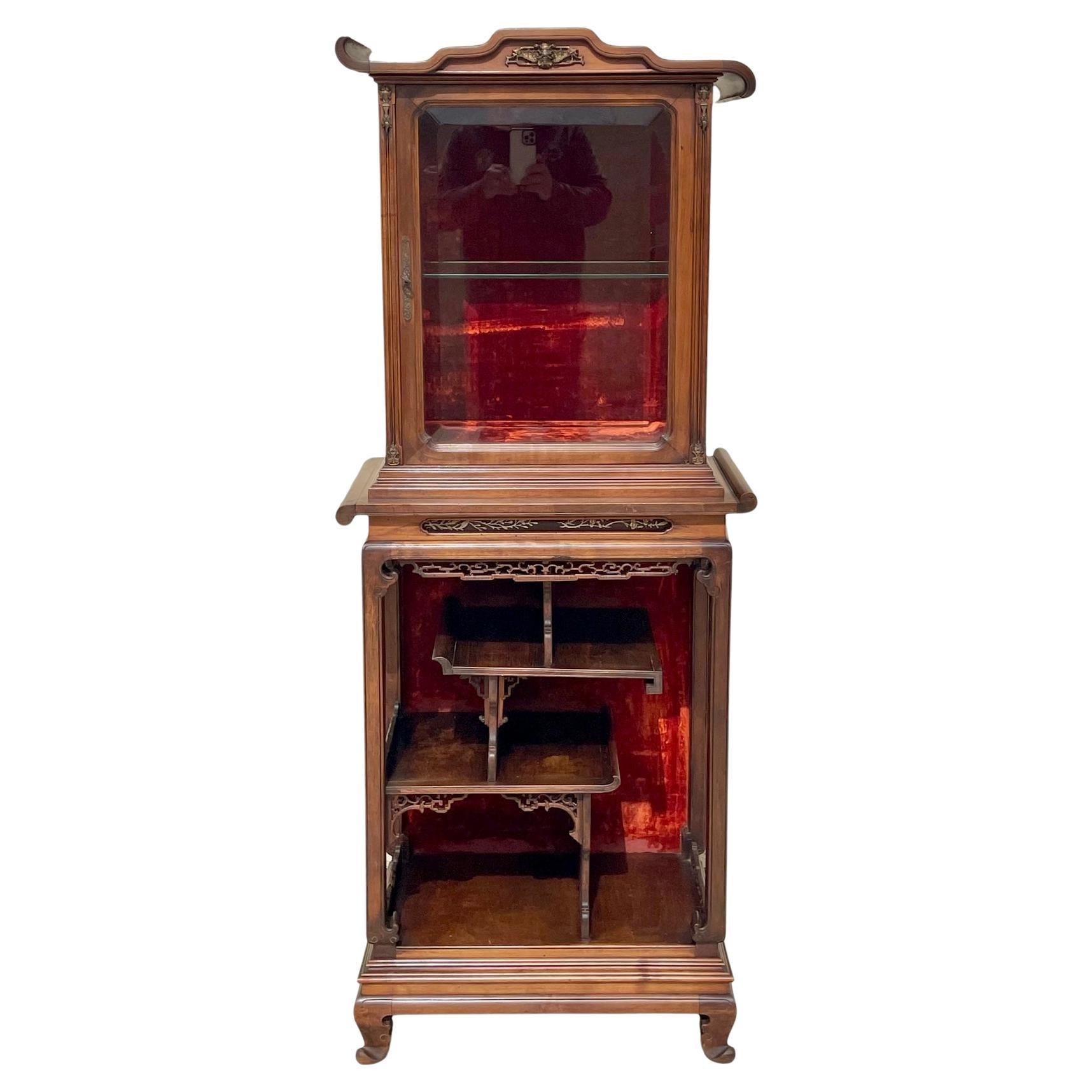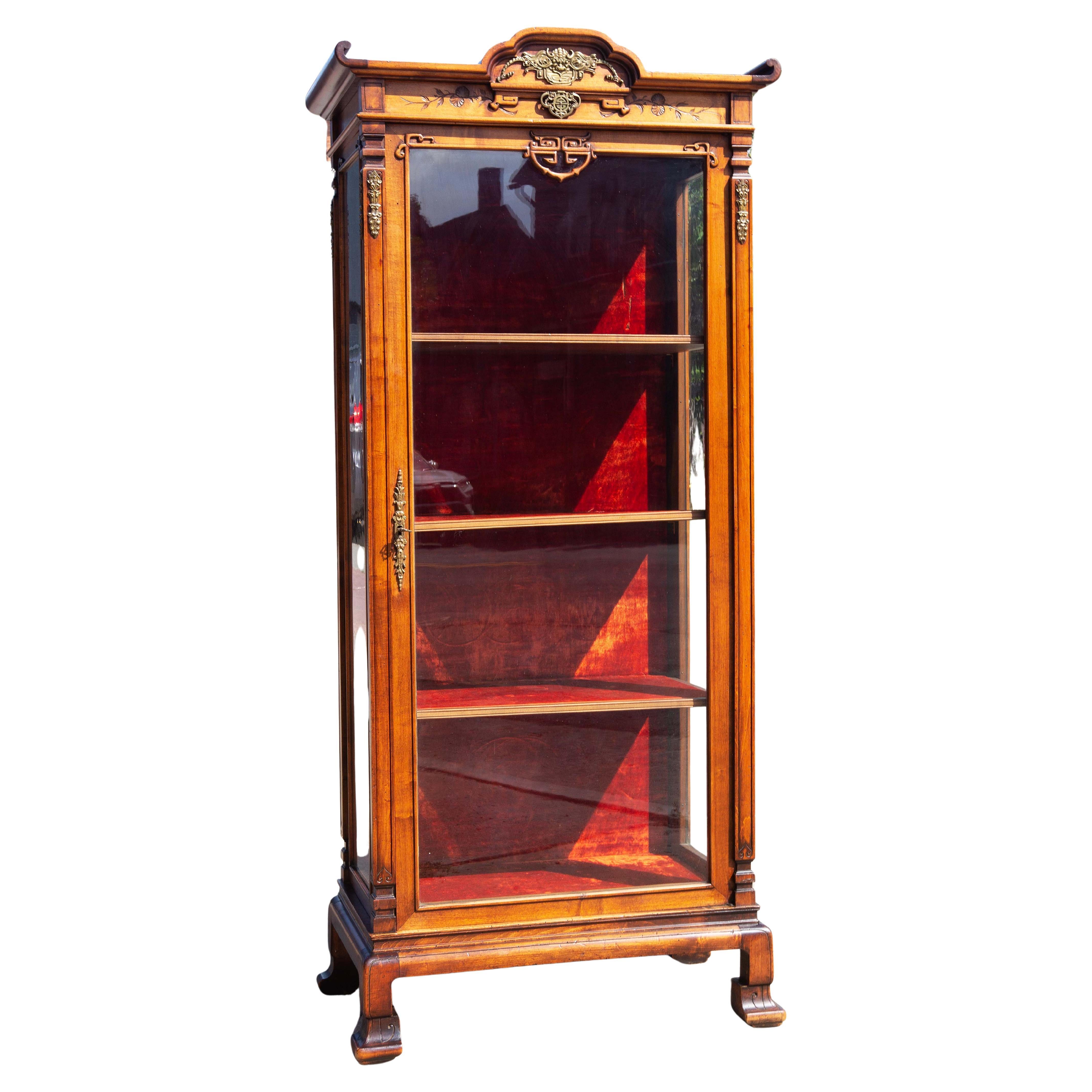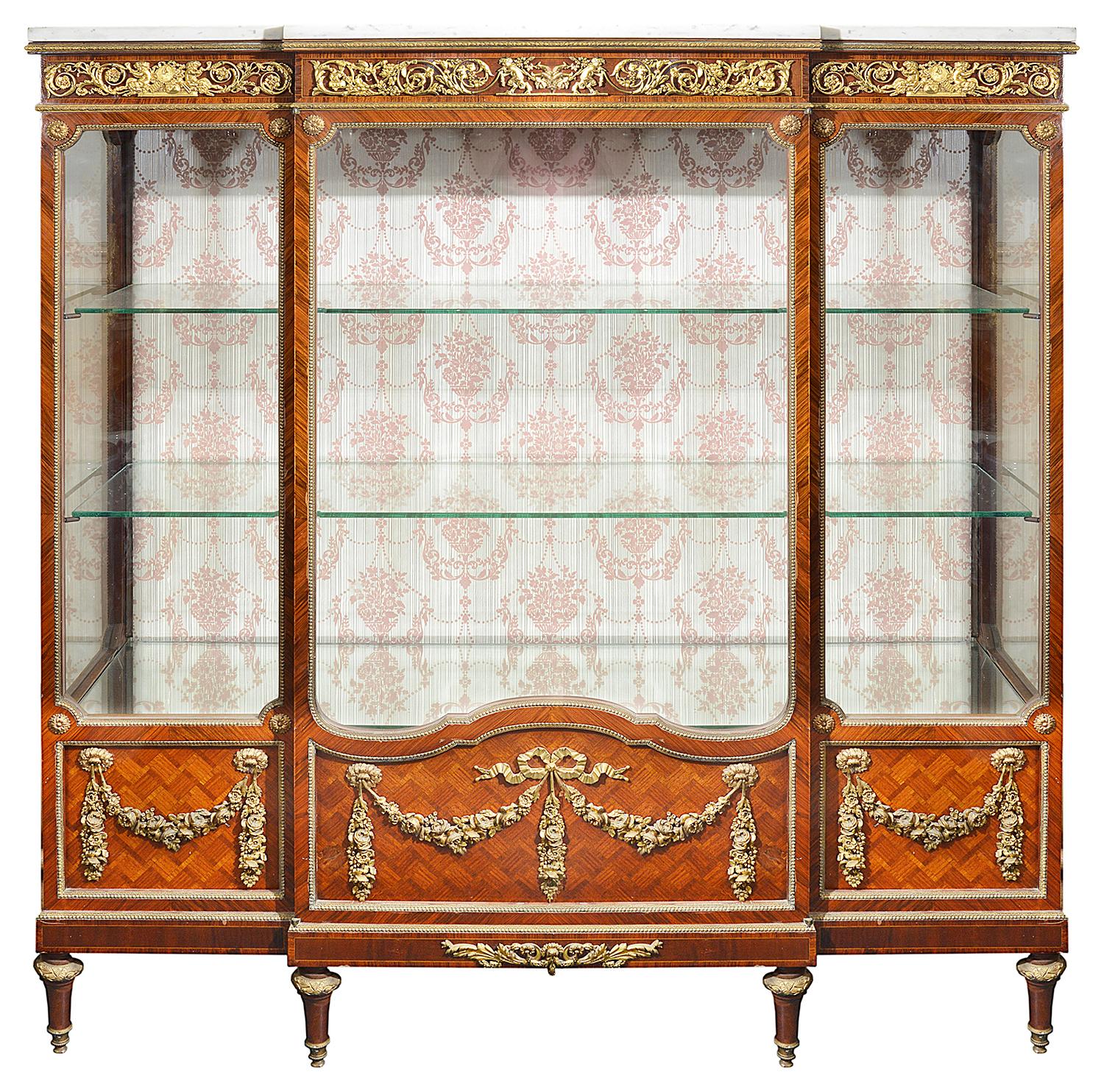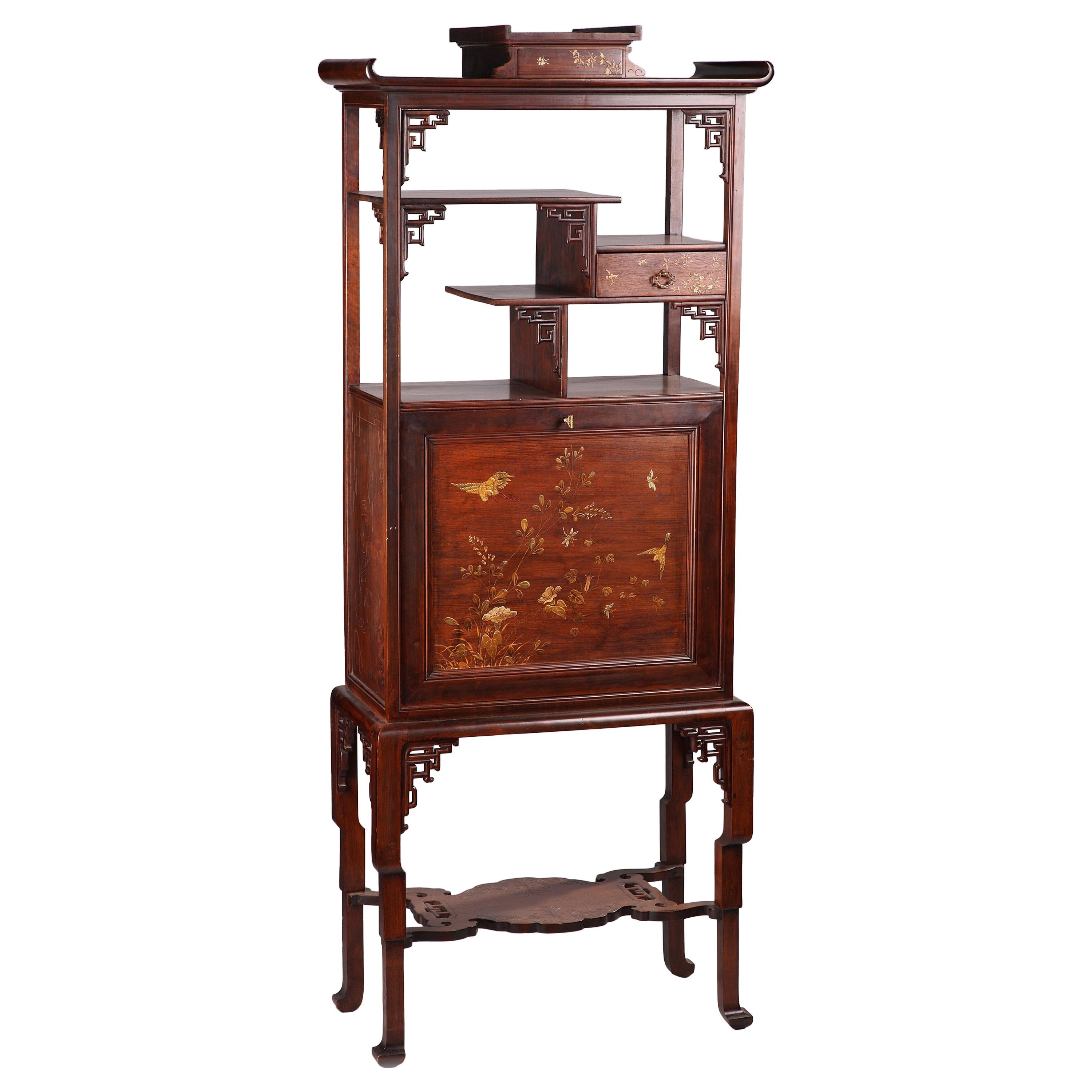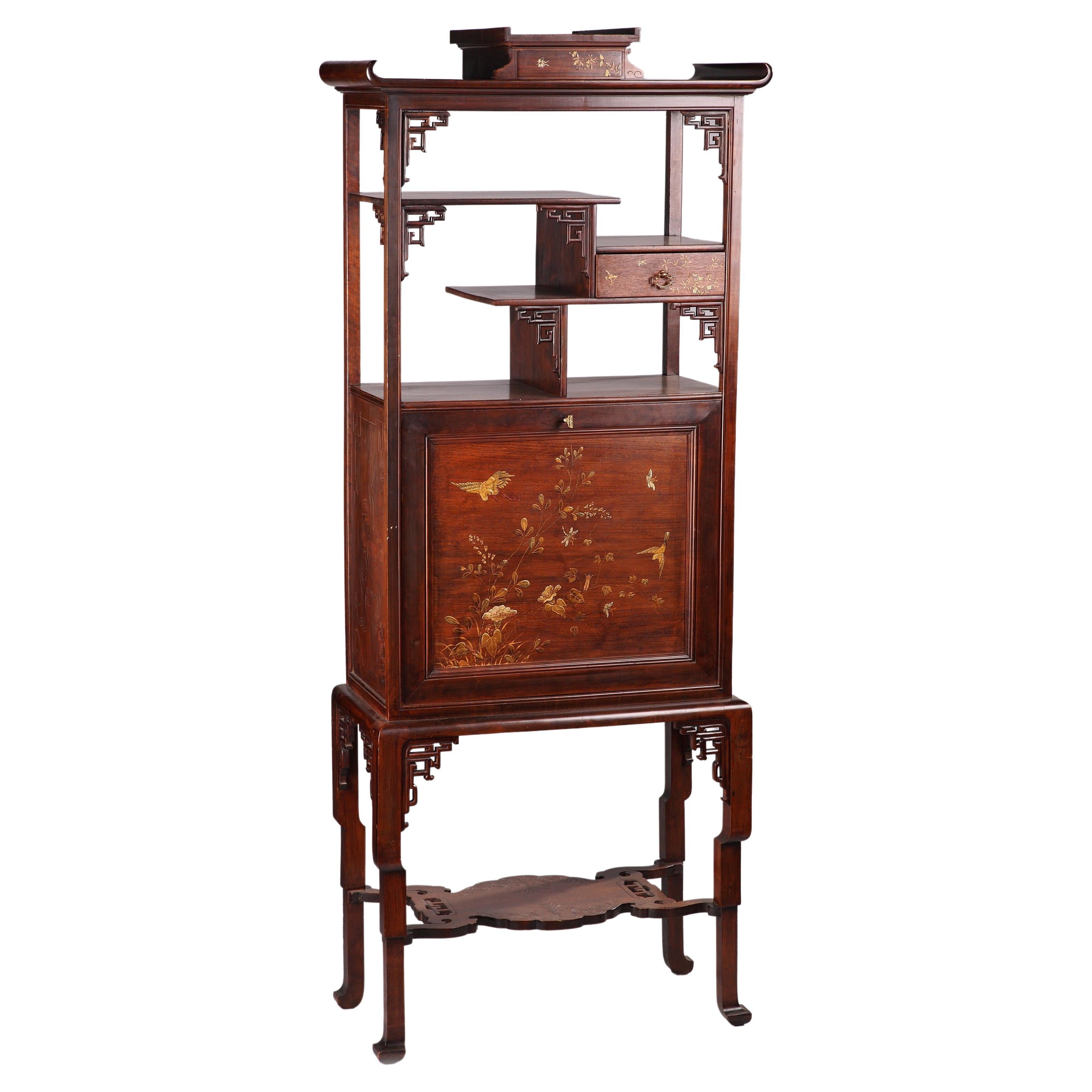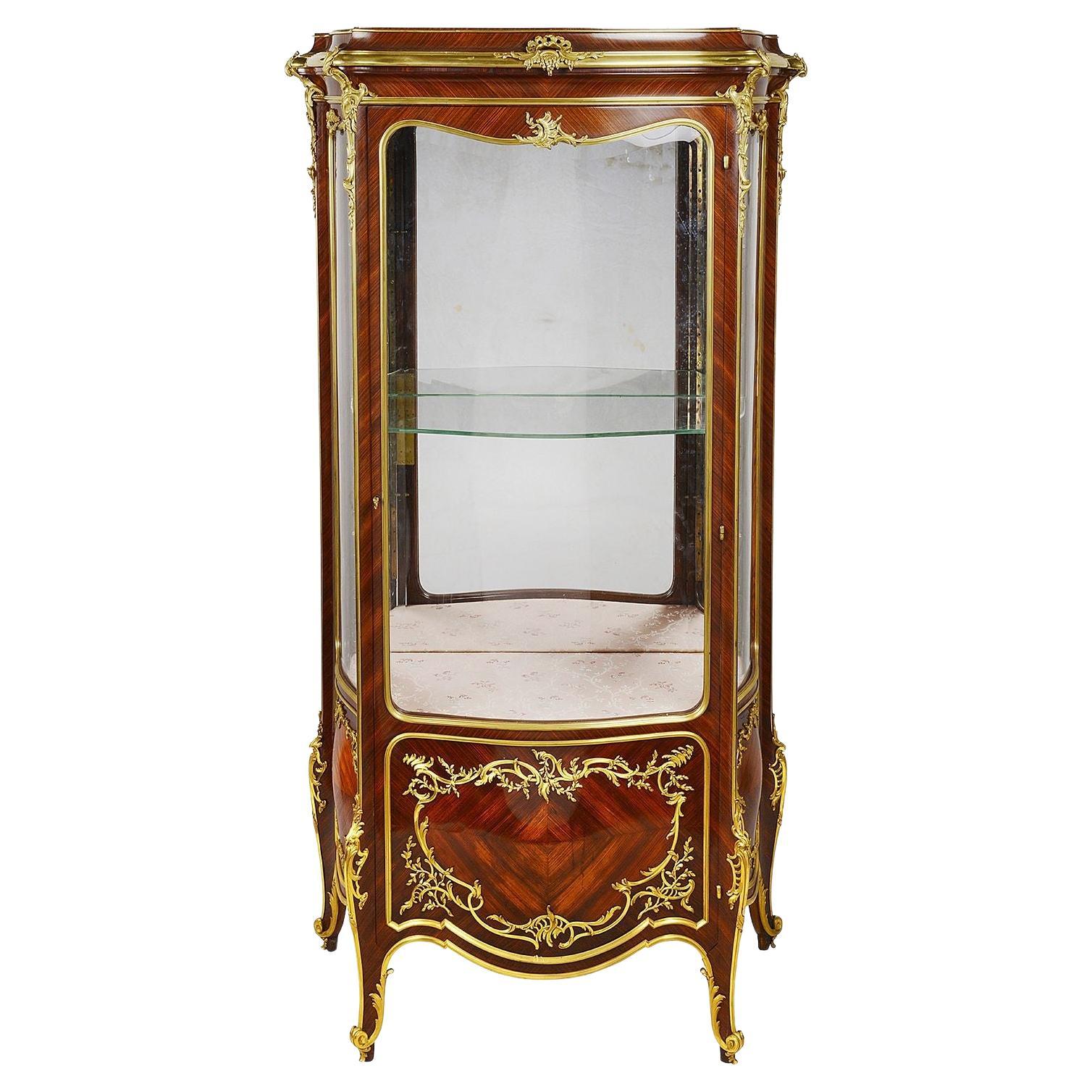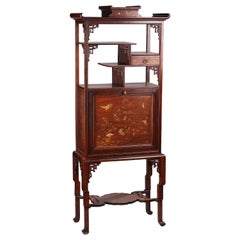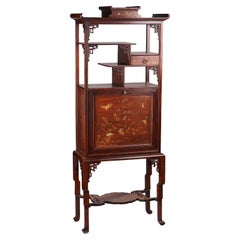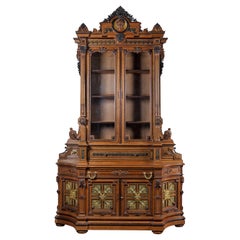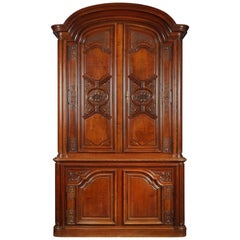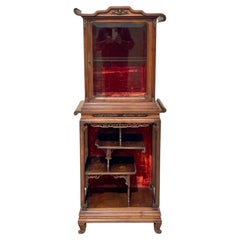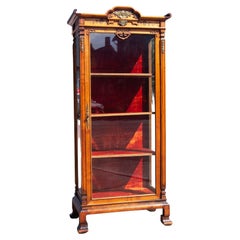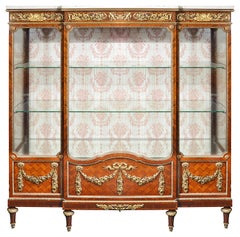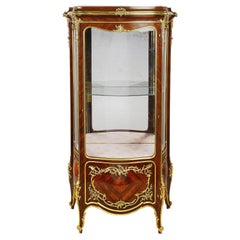Items Similar to "Japonisme" Vitrine Attributed to A. Giroux, France, Circa 1880
Want more images or videos?
Request additional images or videos from the seller
1 of 8
"Japonisme" Vitrine Attributed to A. Giroux, France, Circa 1880
$100,651.16
£75,532.96
€85,000
CA$140,984.39
A$154,709.28
CHF 80,102.22
MX$1,851,996.37
NOK 1,004,962.74
SEK 945,476.50
DKK 647,609.67
About the Item
Rare aesthetic movement showcase, opening in its upper part by two beveled glass doors framed by brass moldings, in its lower part by two door panels in carved walnut decorated with blooming branches and gilded bronze ornaments representing dragons and birds. The sides are carved, like wicker woven.
This showcase is topped by an important carved and gilded walnut cornice depicting a Fô Dog in its center, with a protective power, and rests on elephant head with overtuned trunk shaped feet.
This type of elephant head with overtuned trunk shaped feet is a characteristic of the Maison Giroux, which can be found on many objects they produced. Aesthetic movement cabinet, signed Maison Alphonse Giroux – Paris, Private Collection (see photo attached).
Alphonse Giroux and Company, famous curiosity and luxury goods shop was situated in Paris, at No. 7 rue du Coq-Saint-Honoré and in business from the time of the Consulate until the end of the Second Empire. The company was founded by Francois-Simon-Alphonse and continued in 1838 by his two sons, Alphonse-Gustave (1810-1886) and André (1801-1879). The father became a close associate of the royal family and specialized in the manufacture of refined items for gifts. Kings Louis XVIII and then Charles X were both supplied with gifts for « The Children of France » by Giroux.
Making progressively small furniture, they were mentioned for the first time in 1837 in the class « cabinet-makers » in the Paris Almanach. It was Alphonse-Gustave, however, who really expanded the activities of the firm as is testified by the report of the jury at the 1839 Products of Industry Exhibition awarding him another silver medal. Alphonse was also quick to participate in the famous and soon figured among the best in the luxury goods business. After buying a writing desk at the 1855 Universal Exhibition Napoleon IIIrd bought several other pieces of furniture, candelabras and clocks from Giroux for the Compiègne Palace. In 1857 Alphonse Giroux transferred his shop to No. 43, boulevard des Capucines where he continued to do business until 1867, when he ceded the company to Duvinage and Harinkouck.
- Attributed to:Maison Giroux (Maker)
- Dimensions:Height: 108.27 in (275 cm)Width: 65.75 in (167 cm)Depth: 27.56 in (70 cm)
- Style:Japonisme (In the Style Of)
- Materials and Techniques:
- Place of Origin:
- Period:
- Date of Manufacture:circa 1880
- Condition:Wear consistent with age and use.
- Seller Location:PARIS, FR
- Reference Number:Seller: 15811stDibs: LU3860327545862
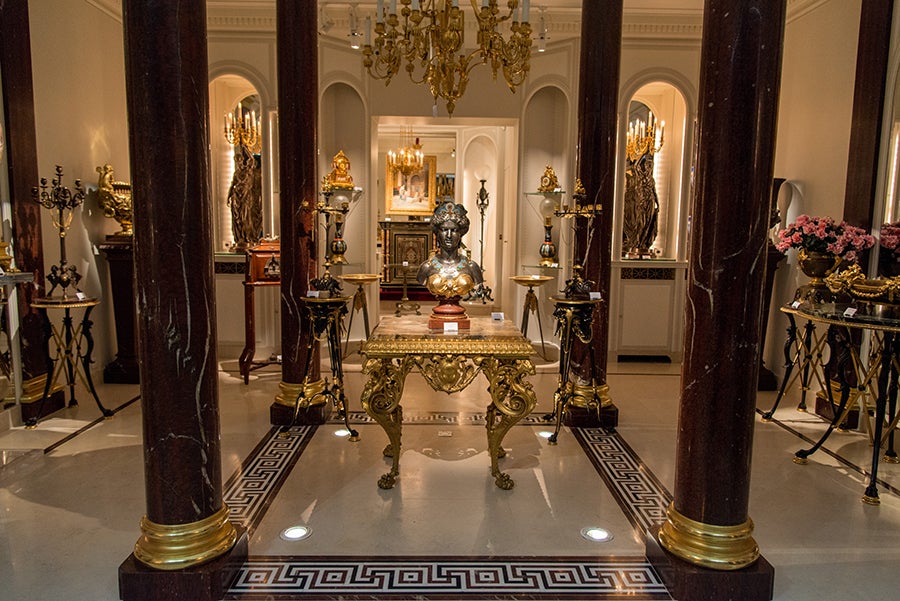
About the Seller
4.9
Gold Seller
Premium sellers maintaining a 4.3+ rating and 24-hour response times
Established in 1997
1stDibs seller since 2018
90 sales on 1stDibs
Typical response time: <1 hour
Associations
International Confederation of Art and Antique Dealers' Associations
- ShippingRetrieving quote...Shipping from: Saint Ouen, France
- Return Policy
Authenticity Guarantee
In the unlikely event there’s an issue with an item’s authenticity, contact us within 1 year for a full refund. DetailsMoney-Back Guarantee
If your item is not as described, is damaged in transit, or does not arrive, contact us within 7 days for a full refund. Details24-Hour Cancellation
You have a 24-hour grace period in which to reconsider your purchase, with no questions asked.Vetted Professional Sellers
Our world-class sellers must adhere to strict standards for service and quality, maintaining the integrity of our listings.Price-Match Guarantee
If you find that a seller listed the same item for a lower price elsewhere, we’ll match it.Trusted Global Delivery
Our best-in-class carrier network provides specialized shipping options worldwide, including custom delivery.More From This Seller
View AllJapanese Style Cabinet-Secretary Attributed to G. Viardot, France, Circa 1880
By Gabriel Viardot
Located in PARIS, FR
A Japanese style carved wood cabinet attributed to G. Viardot. A painted decor imitating Japanese lacquer, ornamented with flowers, birds and butterflies. Opening onto two drawers an...
Category
Antique 1880s French Japonisme Cabinets
Materials
Wood, Paint
Japanese Style Cabinet-Secretary Att. to Perret & Vibert, France, circa 1880
By Perret et Vibert
Located in PARIS, FR
A Japanese style carved wood cabinet, with a painted decor imitating Japanese lacquer, ornamented with flowers, birds and butterflies. Opening onto two drawers and a paper filer, the upright-secretary door is also fitted with red velvet. Surmounted by a drawer and asymmetrical shelves, composed in the Japanese « zen » spirit, the cabinet stands on four legs joined by an engraved stretcher.
The great influence of the Far-East, through China and Japan, in the second half of the 19th century French art could be found first in painting and soon after in decorative arts and furniture as well.
Following the Franco-English military campaign led in 1860 against the Imperial army in China, the French troops of Napoleon III brought back from the Summer Palace, a part of the Chinese Imperial court treasure, which will make up the famous Chinese Museum of Empress Eugénie at the Fontainebleau Palace. The French artists won’t be long to take inspiration from those exotic and sumptuous objects for their creations, as they used to do in the 18th century, when the best French cabinet-makers adapted the Chinese lacquers on the luxurious royal chests.
But the influence of Japan, at the Meiji period (1868-1912), came also very quickly to France, thanks to the opening of the country in the middle of the 19th century, as well as the development of traveling and the amazing Universal Exhibitions, in which Japan participated for the first time in 1867 in Paris. Then many Japanese objects and prints were imported to France and to all Europe, and for which some collectors spent already fortunes.
With Manet and Impressionists generation, the passion for Japanese art, more than a simple taste for an exotic style, was still in fashion until the turn of the 19th century. It provoked not only a craze among the French aristocratic families as well as the wealthy Paris high society, wishing renew their mansion inner decoration, but turned also to a real revolutionary movement among the “avant-garde” artists. Those artists, whoever they were, painters, cabinet-makers or designers of ceramic, bronze and crystal objects, adapted then those techniques and naturalistic motifs unknown until this time.
Christofle, very famous since 1867 as a silversmith, was also one of the leaders among the inventors of Japanism. He knew how to use Japanese elements to his own splendid works made in silver or “cloisonné” enameled bronze. During the 1878 Paris Universal Exhibition, Christofle presented with great success his life-sized bronze Japanese ladies torcheres, executed by the renowned sculptor Guillemin.
Another famous company to be mentioned, is “L’Escalier de Cristal”, producing art objects and furniture, all of high standard quality and innovating much with their Japanese decor. Highly remarked during the Universal Exhibitions, “L’Escalier de Cristal” collaborated with the greatest artists, such Gallé and Rousseau for glass- and ceramic wares, and the cabinet-makers Lièvre and Viardot, whom made furniture including sometimes authentic Japanese elements.
In 1872, Alfred Perret and Ernest Vibert opened in Paris, at 33 rue du Quatre-Septembre a store that offered “natural bamboo furniture and cane seats” and all kinds of textile fittings for furniture. This furniture used for winter gardens and terraces of mansions knew then a resounding success. They developed their business around 1884 with their Japanese style furniture, very close to that executed by Gabriel Viardot (1830-1906). In 1886, the company appearing in the category of “Chinoiserie and Japoneries” offered, in addition to furniture and seating creation, works of art and inlaid furniture directly imported from the Far East ; an activity that expanded rapidly. Their exotic fantasy furniture presented at the Universal Exhibition of Paris in 1889 and 1900, rewarded them two silver medals. In 1894, the company was listed under the name “Perret et Vibert”, headed by the son of Alfred Perret and Ernest Vibert. The same year, they redesigned their store on rue du Quatre-Septembre, creating ten new show-rooms, showing complete furniture sets of Japanese and Chinese style inspiration. It was not until 1895, that the company was finally named “La Maison des Bambous” and organized then in their shops an “exhibition of country furniture and seats for castles and villas”, which was visited by Empress Eugenie to furnish her villa Cyrnos at Cap Martin. She actually was a regular customer of the “Maison des Bambous” as she bought repeatedly furniture. In October of the same year, the king of Greece...
Category
Antique 1880s French Japonisme Secretaires
Materials
Wood
Wooden & Enameled Display Sideboard Attributed to H.A Fourdinois, France, c1867
Located in PARIS, FR
Important two-tiered sideboard attributed to H.A. Fourdinois made in natural and carved wood : the lower part made up of four panels, two concave ones and two doors, richly ornated with a polychrome enameled floral decoration and gilt bronze plaques.
A large dual drawer is surmounted by the upper part of the sideboard, opening with two glazed doors, framed by detached columns. The entire unit is topped with a pediment onto which a female bust is carved in relief within a medallion on a gilt background.
With a matching set of twelve chairs.
The Forney library in Paris preserves order registers of the Fourdinois as well as sketches books and pictures representing pieces of furniture made by the Fourdinois workshops. In this documentation, some elements enable us to link this sideboard with Henri-Auguste Fourdinois’ productions, such as the large scrolls linking the upper part to the lower part of the sideboard, as well as the detached columns carved at their lower third. (picture n°1 attached)
Notebook containing ink-sketches coming from the Fourdinois workshop shows a project for a pelmet, beautified with a centering trophy composed of a torch and a quiver within in a foliage wreath, this motif obviously reused by the Fourdinois on the central decoration of the panels of our sideboard. (picture n°2 attached)
The firm of Fourdinois, considered during the Second Empire as the greatest furniture manufacturer in Paris, was founded in 1835 by Alexandre-Georges Fourdinois (1799-1871). It was developped in the context of the Expositions Universelles. At the time, the firm already produces furniture of the Neo-Renaissance style, such as a dresser that won the Great Medal at the London Universal Exhibition of 1851. The son, Henri-Auguste Fourdinois (1830-1907), joined the firm in 1860 and will become head of the firm in 1867. The high quality of his designs was remarked at the Universal Exhibition in 1862, when the jury awarded him two medals « for Excellence of Composition and Execution ». Henri-Auguste, now sole in charge, brought the firm to the summit of its achievements at the 1867 Universal Exhibition in Paris by winning the Grand Prize for his stand. Apart from the commissions he executed for the « Mobilier de la Couronne », he also produced high quality furniture for the Parisian bourgeoisie. The firm is at its zenith during the years 1862-1880. At this time, it is considered as an example to follow for other cabinet-makers, whether they are French, British or American.
Through the quality of execution and the extreme care taken in the decoration of furniture, H.-A. Fourdinois was particularly appreciated by Napoleon III and Eugenie...
Category
Antique 1860s French Renaissance Sideboards
Materials
Enamel, Bronze
Regence Style Wooden Display-Cabinet by C. Potheau, France, circa 1895
By Potheau
Located in PARIS, FR
Signed Constantin Potheau, ébéniste, Paris.
Measures: Height 275 cm (108,2 in., width 160 cm (63 in.);
Upper part depth 48 cm (18.8 in.) / inside 42 cm (16.5 in.)
Lower part dept...
Category
Antique 1890s French Régence Buffets
Materials
Wood
Renaissance Style Wooden Cabinet Attributed to H.A. Fourdinois, France, 1893
Located in PARIS, FR
A wooden cupboard, elaborately carved throughout, dated "1893" on the crest and attributed to H.A. Fourdinois. The upper section with a pair of cherubs at the center of a balustrade ornamented with two-handled urns, two architectonic doors below, carved with lady and gentleman in niches surrounded by extensive carving with classical motifs. The lower section with two drawers above a standing female caryatid support at each front corner. The all reposing on four gadronned round feet.
The Fourdinois company was founded in 1835 by Alexandre-Georges Fourdinois (1799-1871). The Universal Exhibition held in London in 1851 was undoubtedly their first great artistic and public success. Winning the Great medal for a neo-Renaissance buffet...
Category
Antique 1890s French Renaissance Cabinets
Materials
Wood
$15,630 Sale Price
40% Off
Neo-Renaissance Cabinet by P. Sormani and attr. to E. Lièvre, France, Circa 1870
By Edouard Lievre, Paul Sormani
Located in PARIS, FR
Signed twice on the lock P. SORMANI 10 rue Charlot Paris
Rare neo-Renaissance cabinet in carved wood and Portor marble, adorned with chiseled and gilded bronze.
The upper, part, surmounted by a frieze of posts and marble cabochons, consists of a central door decorated with a carved panel representing the birth of Venus, framed by two pairs of ringed and fluted columns with Corinthians capitals in gilded bronze revealing two doors with secret opening. Two drawers with lion’s head shaped handles and a central drawer decorated with tracery in gilded bronze complete the upper part of this cabinet.
In the lower part, two drawers on the belt with diamond...
Category
Antique 1870s French Renaissance Cabinets
Materials
Marble, Bronze
$64,416 Sale Price
38% Off
You May Also Like
Attr. to Gabriel Viardot - Japanese Vitrine / Cabinet
By Gabriel Viardot
Located in Beaune, FR
Lovely little Japanese-style vitrine in carved wood in the style of Gabriel VIARDOT. Vitrine in the upper part and shelves in the lower part. This small piece of furniture is in good...
Category
Antique 19th Century French Chinese Export Vitrines
Materials
Fruitwood
19th Century French Japonisme Cabinet Attributed to Gabriel Viardot
Located in Rochester, NY
Exotic Japanese French vitrines attributed to Gabriel Viardot. Carved hardwood with Fine brass mounts. Interior with old silk velvet. Great size. France. 19th century.
Gabriel Vi...
Category
Antique 19th Century French Cabinets
Materials
Brass
19th Century Linke Influenced Display Cabinet
By François Linke
Located in Brighton, Sussex
A very good quality late 19th century French parquetry inlaid vitrine / display cabinet.
Having its original Carrera marble top, wonderful gilded ormolu mounts of scrolling foliate ...
Category
Antique Late 19th Century French Louis XIV Vitrines
Materials
Ormolu
Fine French 19th Century Display Cabinet, Attributed to Francoise Linke
By François Linke
Located in Brighton, Sussex
A fine quality French 19th Century Louis XVI style bombe fronted vitrine / display cabinet. Having wonderful scrolling foliate gilded ormolu mounts, bombe shaped glass to the front a...
Category
Antique 19th Century French Vitrines
Materials
Kingwood, Mahogany
19th Century French Vitrine
By François Linke
Located in Brighton, Sussex
A fine quality French kingwood, marble topped vitrine having shaped glass to the front and sides. Beautiful ormolu mounts and raised on cabriole legs. The the manner of 'Linke.'.
Category
Antique 1890s French Vitrines
Materials
Ormolu
$7,475 / set
19th Century French Demilune Vitrine Display Cabinet
Located in Tarry Town, NY
Embrace the timeless allure of our antique demilune-shaped vitrine and china cabinet, Beautifully finished in a warm, inviting red stain. T...
Category
Antique 19th Century French Victorian Vitrines
Materials
Brass
More Ways To Browse
Used Luxury Goods
French Japonisme
Louis Xviii
Trunk Feet
Curiosity Shop
1880 French Vitrine
Alphonse Giroux
Fo Dog
Maison Alphonse Giroux
Art Deco Glass And Mirror Vitrine
Glass Medical Cabinet
Dutch Vitrine Cabinet Storage
French Napoleon Iii Vitrine
Display Cabinet 1930s
French Empire Vitrine
Marble Top Vitrine
Mastercraft Brass Glass Cabinet
French Empire Vitrine Cabinet
